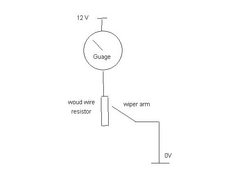
Fuel Gauge Not Working
Chaz - 27/3/07 at 07:36 PM
Probably the most boring thread i've written....but most annoying problem yet!
I have a fuel sender which (using a multimeter) reads 4.5ohms empty and 194.5ohms full.
I have a smiths gauge, and i doesn't work with this sender, why not?
Have i got the wrong gauge/sender, can i use a resistor or something else to fix it?
Also i thought that a simple test could narrow down the problem. With power on the gauge shoots to full, so i thought i could test it by using the
wires at the sender end. I touch the wires together and there should be no resistance and hence the gauge should read full/empty. Does this test work?
Can anyone help?
Thanks
Chaz
Ian D - 27/3/07 at 08:47 PM
Just a thought. Should the resistance not reduce when full so that a greater current flows. Hence the needle move further up the scale. where as in
your case you have the highest resistance when full and least current flow so your needle is stuck on empty. try shorting and see what happens.
Alternatively you dont have an upwards mounted sender when you are mounting it downwards? Creatinga reverse action?
Ian
Chaz - 27/3/07 at 09:18 PM
When i connected the gauge to the sender i held the sender and moved the lever through its full range and nothing happened from 4.5ohms all the way to
194.5ohms. I've also tried shorting it out, nothing happened.
Any more ideas? Or solutions?
BenB - 27/3/07 at 09:30 PM
If the resistance is changing but it's not what the dial is expecting I reckon its the wrong sensor for the dial. If the sensor failed
you'ld expect to either short to earth or go to an open connection....
Macbeast - 27/3/07 at 09:38 PM
According to Practical Classics ( just happened to be reading earlier this evening ) disconnect wire to sender and turn on ignition, Gauge should read
empty. Now earth the sender wire with ignition on, gauge should read full.
Check with your meter that you are getting 12V (or maybe 9V after voltage regulator) on sender wire.
There are probably two terminals on your sender - one should be 12V feed from gauge the other connected to earth / chassis. But the earth one may also
be earthed inside the sender to the body.
If you had the sender terminals the wrong way round you might have a permanent earth on the gauge wire which would give you permanent full reading,
which I think is what you said.
Confused ? You will be 
02GF74 - 28/3/07 at 08:47 AM
don't follow how you have wired your guage up but all the guages I have worked on (2 different types  ) are wired as below.
) are wired as below.
The sender that goes in the tank can have 1,2 or 3 tabs. The insulated tab would go to the wiper, another insulated tab can be low fuel warning lamp
(you probably won;t have this) and third tab would be connected to sender body which goes to earth. If the last connection is not there, then the
earthing is doen via the screws to the tank and then a lead from tank to to the chassis.
On the guage side you have two leads, one goes to a power supply, usualy 12 V or a voltage regulator (usually 9 V) the other goes to the insulated tab
on the sender.
Now usaully when the guage sees low resistance, it read full - and vice versa for empty.
Dicponnect guage wire = empty
Earth gauge wire = full.
The range of resistance for you guage sound right.
re: With power on the gauge shoots to full,
<<<<-- is the tank full? 
There are land rover fuel guages (smiths) that work in opposite way to how I described earlier.
No point shorting out your wires until you have described ecactly, ideally with photo how you have wired up guage and sender.
[Edited on 28/3/07 by 02GF74]


Rescued attachment guage.JPG


 ) are wired as below.
) are wired as below.